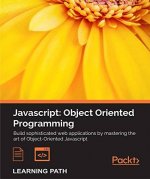Impostor Syndrome
Honorary Poster
- Joined
- Mar 7, 2015
- Posts
- 586
- Reaction
- 466
- Points
- 246

- Length: 647 pages
- Edition: 1
- Language: English
- Publisher: Packt Publishing
- Publication Date: 2016-08-31
Build sophisticated web applications by mastering the art of Object-Oriented Javascript
About This Book
- Learn popular Object-Oriented programming (OOP) principles and design patterns to build robust apps
- Implement Object-Oriented concepts in a wide range of frontend architectures
- Capture objects from real-world elements and create object-oriented code that represents them
- Learn the latest ES6 features and how to test and debug issues with JavaScript code using various modern mechanisms
Who This Book Is For
JavaScript developers looking to enhance their web developments skills by learning object-oriented programming.What You Will Learn
- Get acquainted with the basics of JavaScript language constructs along with object-oriented programming and its application.
- Learn to build scalable server application in JavaScript using Node.js
- Generate instances in three programming languages: Python, JavaScript, and C#
- Work with a combination of access modifiers, prefixes, properties, fields, attributes, and local variables to encapsulate and hide data
- Master DOM manipulation, cross-browser strategies, and ES6
- Identify and apply the most common design patterns such as Singleton, Factory, Observer, Model-View-Controller, and Mediator Patterns
- Design applications using a modular architecture based on SOLID principles
In Detail
JavaScript is the behavior, the third pillar in today’s paradigm that looks at web pages as something that consists of : content (HTML), presentation (CSS), and behavior (JavaScript). Using JavaScript, you can create interactive web pages along with desktop widgets, browser, and application extensions, and other pieces of software. Object-oriented programming, which is popularly known as OOP, is basically based on the concept of objects rather than actions.The first module will help you master JavaScript and build futuristic web applications. You will start by getting acquainted with the language constructs and how to organize code easily. You develop concrete understanding of variable scoping, loops, and best practices on using types and data structures, as well as the coding style and recommended code organization patterns in JavaScript. The book will also teach you how to use arrays and objects as data structures. By the end of the book, you will understand how reactive JavaScript is going to be the new paradigm.
The second module is an easy-to-follow course, which includes hands-on examples of solutions to common problems with object-oriented code. It will help to identify objects from real-life scenarios, to protect and hide data with the data encapsulation features of Python, JavaScript, and C#. You will discover the advantage of duck typing in both Python and JavaScript, while you work with interfaces and generics in C#. With a fair understanding of interfaces, multiple inheritance, and composition, you will move on to refactor existing code and to organize your source for easy maintenance and extension.
The third module takes you through all the in-depth and exciting futures hidden behind the facade. You should read through this course if you want to be able to take your JavaScript skills to a new level of sophistication.
Style and approach
This course is a comprehensive guide where each chapter consists of best practices, constructive advice, and few easy-to-follow examples that will build up your skills as you advance through the book. Get object oriented with this course, which takes you on a journey to get acquainted with few useful hands-on tools, features, and ways to enhance your productivity using OOP techniques. It will also act as a reference guide with useful examples on resolving problems with object-oriented code in Python, JavaScript, and C#.Table of Contents
Chapter 1: Javascript PrimerChapter 2: Functions, Closures, And Modules
Chapter 3: Data Structures And Manipulation
Chapter 4: Object-Oriented Javascript
Chapter 5: Javascript Patterns
Chapter 6: Testing And Debugging
Chapter 7: Ecmascript 6
Chapter 8: Dom Manipulation And Events
Chapter 9: Server-Side Javascript
Chapter 10: Objects Everywhere
Chapter 11: Classes And Instances
Chapter 12: Encapsulation Of Data
Chapter 13: Inheritance And Specialization
Chapter 14: Interfaces, Multiple Inheritance, And Composition
Chapter 15: Duck Typing And Generics
Chapter 16: Organization Of Object-Oriented Code
Chapter 17: Taking Full Advantage Of Object-Oriented Programming
Chapter 18: Object-Oriented Javascript
Chapter 19: Primitive Data Types, Arrays, Loops, And Conditions
Chapter 20: Functions
Chapter 21: Objects
Chapter 22: Prototype
Chapter 23: Inheritance
Chapter 24: The Browser Environment
Chapter 25: Coding And Design Patterns
Chapter 26: Reserved Words
Chapter 27: Built-In Functions
Chapter 28: Built-In Objects
Chapter 29: Regular Expressions
You do not have permission to view the full content of this post. Log in or register now.
Attachments
-
You do not have permission to view the full content of this post. Log in or register now.